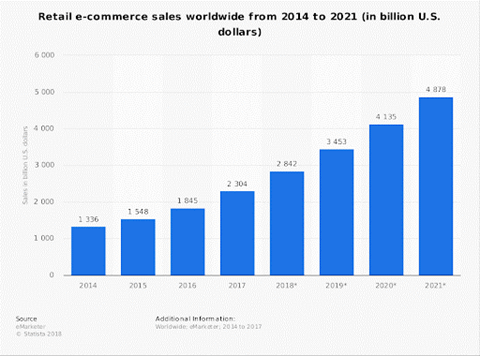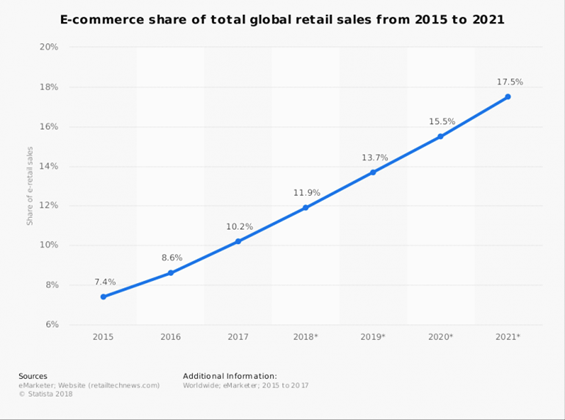As we approach the close of 2020, what remains certain is: The Supply Chain industry has witnessed a lot of changes this year. The impact of COVID-19 on Supply Chian was unprecedented and the changes, as a result, aren’t all shocking. Early in March, the implementation of the stay-at-home orders worldwide saw an unprecedented report in Supply Chain and other key areas. Notably, Statista stated a 21% uprise in monthly social media usage. So, with these unprecedented circumstances what Supply Chain Trends we should expect?
Nevertheless, all through the year 2020, the key Supply Chain Trends saw consumers use social channels to complete and get orders across without delays. The growth of the eCommerce sector was positively embraced due to the pandemic. These moves saw Jeff Bezos, founder of Amazon, break multiple financial to becoming the first Person Ever to worth over $200 Billion.
The global market is still expanding. As we continue to discover more solutions and vaccines to handle the pandemic, brands are not just speculating how they’ll get considerable engagements in the coming year. They’re also asking, “What Supply Chain Trends should I expect in this changing landscape?”
Well, thankfully, as we approach the new year, I would like to share my views on Supply Chain Trends to Watch out for in 2021 and beyond. I’ve compiled the biggest 5 Supply Chain Trends to spark new discussion, overcome critical hurdles, and leverage to maintain a successful Supply Chain business for the years to come.
- Supply Chain Digitalization Will be Top Agenda Topic for CEO’s
- There will more focus on Employee Development
- Working from Home will be Accepted Norm
- Excessive focus on e-Commerce
- More focus on Localization rather than Outsourcing
Supply Chain Digitalization Will be Top Agenda Topic for CEO’s
Supply Chain 4.0 is amongst the leading Supply Chain Trends set to come on board in 2021. The Supply Chain Digitalization would see the application of IoT (Internet of Things), advanced robotics, and advanced analytics of big data in SCM. More sensors and networks would be seen in every aspect of the supply chain. The innovations will analyze and automate anything with significance to improving overall customer satisfaction and performance.
The past three decades have seen logistics undergo several tremendous changes: moving from purely operational function (with sales report focused on ensuring supplies and delivery to final consumers) to a more autonomous supply chain management function. SCM function’s focus is shifting to cater to advance planning processes, such as analytical demand planning, which are becoming established business processes.
Industry 4.0 is creating disruption and entails businesses to rethink their ideas, designs, and supply chain. There is continuous growth in rural areas globally, with wealth shifting into regions like never before. The pressure to be more environmentally friendly and socioeconomic regulations adds to the current challenges. Consumer expectations are growing: the online trend has led to rising service expectations mixed with a much stronger organization of orders.
The Supply Chain Digitalization would definitely trend towards more customization and individualization towards driving strong growth and transformations in the SKU portfolio. The online-powered transparency and easy accessibility to several shopping options would drive the supply chain competition.
To build on this particular trend and cope with the required changes, Supply Chain Digitalization is about becoming more faster, granular, and have more precise. Supply Chain 4.0 would enable companies to address these new requirements of customers and the supply side challenges alongside expectations for efficiency improvement. The Supply Chain Trends following Supply Chain 4.0 will see digitization be: …
- Faster: New methods for distribution and shorter delivery time would be the basis for these services. They would be built using advanced forecasting approaches, like predictive analytics of external (e.g., construction indices, market trends, weather) and internal (e.g., demand) data, including machine status data, to provide a much more precise forecast.
- More Accuracy: The next-gen of performance management systems delivers real-time, end-to-end transparency all through the supply chain. The information span would cover synthesized top-level KPIs, including the overall service level. This data range provides a combined information basis for all seniority levels and functionalities across the supply chain. The data integration into a “supply chain cloud” would ensure all stakeholders are well informed using the same facts.
- More Flexibility: Real-time planning permits for flexible reaction in varying demand/supply situations. Minimal planning cycles and frozen periods becomes a continuous process with the ability to react dynamically to changing constraints/ requirements. New business models, like Supply Chain as a Service, would increase the flexibility for most supply chain firms.
- More Granular: Customers’ demand for more individualized products is endlessly increasing. A strong push for micro-segmentation and mass customization concepts might be implemented. Customers management will receive more offers in granular clusters and a wide-ranging spectrum of suited products. New transport concepts, like drone delivery, would allow brands to accomplish the last mile efficiently.
In Supply Chain Digitalization and performance management systems, we expect to see performance management systems with “learning” abilities to automatically detect risks or exceptions and alter supply chain parameters using a closed-loop learning approach. That automatic approach would enable the effective handling of a broad spectrum of anomalies with less human involvement.
There will More Focus on Employee Development
At the very top, employee development involves working with employees to enhance, hone, and refine existing skills. It may also involve the addition of new skills. This Supply Chain Trends would definitely see new skills springing up, and employee’s development would be in line to meet organizational strategies. The employee development necessitates investment (effort, financing, and time), but once done right, the investments will pay off over time.
One of the greatest challenges in the “New Normal” would be to maintain the team and organizational culture intact while employees are getting used to working from home. This is where the Learning & Development executives, need to find new ways to engage.
And the focus should not just go into developing technical competencies, it should be in 3 dimensions:
- Technical Supply Chain Competencies (also includes Materials Management & Logistics)
- Digital Supply Chain Knowledge (Read 8 C’s of How to Make Your Supply Chain Digital)
- Soft Skills (see this episode of The Supply Chain Show with Linkedin Voice Radu)
Working From Home Will be Accepted Norm
Working from Home became the new normal in 2020, and 2021 is likely to continue that way. Apart from the added flexibility workers enjoy at Home, it also gets many demands done on time. This Supply Chain Trends would see more job roles completed from Home but would also see some unique requirements. From the American Time Use Survey, a massive 57% of employees in 2018 had flexibility with their schedule. In addition, 29% of employees (totaling 42 million wage and salary workers) can work from Home, and 25% (36 million workers) worked from home at some point.
Some employees also are show willingness to take a pay cut in order to work from Home. According to the study by Owl Labs, the State of Remote Work 2019 report shows some 24% and 34% of workers are willing to take 10% and 5% cut, respectively. Also, the report shows 20% of workers are ready to take larger cuts than 10%.
There are several reasons for workers to want to perform more jobs remotely in the coming years. From better work-life balance, increased productivity/better focus, less stress, avoiding the commute, it’s easy to see these Supply Chain Trends play a key role in 2021.
Firms and supply chain brands are more likely to see more employees work from Home, even with tight workplace schedules. Also, companies would have to do a lot in this area to entice top talents, including flex time and work-from-home possibilities. The survey by Robert Half shows 77% of employees are noted to be more likely to take jobs offering the ability to work from home at least for specified periods.
Excessive Focus on e-Commerce
The growing eCommerce landscape is always exciting with new revolutions. Each year features changes that may bring rapid growth or challenges. By 2021, this Supply Chain Trends is set to be promising on all fronts. To keep up with whatever ups or downs, businesses need to up their game in the ever-expanding eCommerce market. The key supply chain trends in the e-Commerce sector would be:
- Studies show the growth of Global eCommerce retail sales likely to hit $4.9 trillion by 2021 (a new high). The eCommerce businesses are also to anticipate a 265% growth rate, from $1.3 trillion to $4.9 trillion between 2014 and 2021.
- Even more impressive is the global growth of eCommerce sales in total global retail sales. It is also expected by 2021, it will represent 5% of the whole global retail sales. This growth means more opportunities and prospects for the future.
- Omnichannel shopping would see more popularity. With digital innovations becoming more prevalent, multiple channels will become more accessible in customers’ purchase path. This prevalence is demonstrated by 73% of customers using various channels during their shopping expedition.
- Increase in Social shopping and possible shift of eCommerce center. The movement from the western hemisphere for eCommerce implies businesses need to adopt a more international tactic in ensuring their global availability and convenience. The US stake of the overall global eCommerce is predicted to see a 9% decrease in 2020. A significant driver in this decrease is its growth of globalization, technological improvement, and infrastructure advances.
- The emergence of payment options remains one essential driver of Supply Chain Trends to aid customers in 2021. To stay competitive, current digital wallets are required to provide a frictionless shopping experience. In effect, a whopping 70% of individuals expect digital payment solutions to overhaul cash and cards by 2030. Nonetheless, another payment option on the rise is the use of cryptocurrency. To date, we can observe the massive adoption and large business transactions using cryptocurrencies.
In 2021, ensure to integrate both offline and online attributes into your supply chain channels.
More Focus on Localization Rather than Outsourcing
The localization of supply chains globally amidst the pandemic forces businesses to make a trade-off between efficiency and resilience. With the news of groundbreaking vaccines coming out soon, 2021 would likely see more focus on localization than outsourcing as Supply Chain Trends.
Over the past several decades, cross-border trade has faced full-blown expansion to include global supply networks. That is now changing, though, as the pandemic limited the globalization practice, at least for the moment. Businesses today are seeking to prioritize resilience over efficiency as more focuses on localization to curb this disruption.
The shift is already happening before the pandemic and has simply reinforced these Supply Chain Trends. A new survey from McKinsey shows supply chain executives are planning to focus on resilience, with 40% of 60 respondents actively seeking nearshoring resolutions.
The regulators also would have a role to play in assisting businesses to create global networks that limit the risks of wholly sourcing from specific locations. While we may see some return to international markets, it probably would not be sufficient to make a massive difference in the coming years.
While the global trade saw a fall in 2020 (UNCTAD predicts a 7% drop and the WTO estimates a 9% fall), Asia remains the least affected as its GDP continues to grow. Countries like China and Singapore have accelerated using digital technologies to aid ease the effect of the pandemic.
Final Words
The ever-changing landscape of the Supply Chain world is both exciting and scary. Each year comes with changes that give room for growth and new business ideas to tackle old challenges. But, whatever the ups and downs faced in 2020, the coming year will be promising to be Good One ?
About the Author- Dr Muddassir Ahmed
Dr MuddassirAhmed is the Founder & CEO of SCMDOJO. He is a global speaker, vlogger and supply chain industry expert with 17 years of experience in the Manufacturing Industry in the UK, Europe, the Middle East and South East Asia in various Supply Chain leadership roles. Dr. Muddassir has received a PhD in Management Science from Lancaster University Management School. Muddassir is a Six Sigma black belt and founded the leading supply chain platform SCMDOJO to enable supply chain professionals and teams to thrive by providing best-in-class knowledge content, tools and access to experts.
You can follow him on LinkedIn, Facebook, Twitter or Instagram








